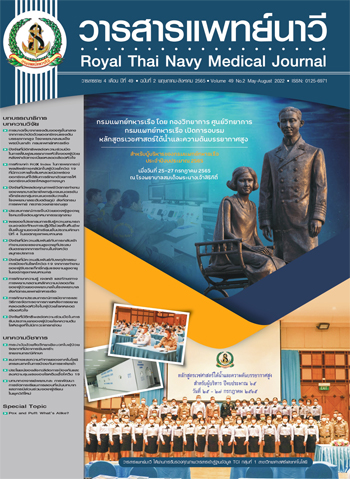การศึกษาค่า ROX Index ในการพยากรณ์ผลลัพธ์ทางคลินิกในผู้ป่วยโควิด 19 ที่มีภาวะหายใจล้มเหลวชนิดพร่องออกซิเจนที่ได้รับการรักษาด้วยการให้ออกซิเจนอัตราไหลสูงทางจมูก
Main Article Content
บทคัดย่อ
การวิจัยเชิงสังเกตการณ์แบบย้อนหลังครั้งนี้มีวัตถุประสงค์เพื่อศึกษาค่า Respiratory rate and oxygenation index (ROX index) ในการพยากรณ์ผลลัพธ์ทางคลินิกในผู้ป่วยโควิด 19 ที่มีภาวะหายใจล้มเหลวชนิดพร่องออกซิเจนที่ได้รับการรักษาด้วยการให้ออกซิเจนอัตราไหลสูงทางจมูก กลุ่มตัวอย่าง คือข้อมูลผู้ป่วยโควิด 19 ที่มีภาวะหายใจล้มเหลวชนิดพร่องออกซิเจนที่ได้รับการรักษาด้วยการให้ออกซิเจนอัตราไหลสูงทางจมูกที่เข้ารับการรักษาในโรงพยาบาลสมเด็จพระปิ่นเกล้า จำนวน 113 ราย เก็บรวบรวมข้อมูลย้อนหลังจากเวชระเบียนผู้ป่วยระหว่างวันที่ 1 กุมภาพันธ์ ถึง 31 กรกฎาคม พ.ศ. 2564 วิเคราะห์ข้อมูลโดยใช้สถิติเชิงพรรณนา วิเคราะห์ Receiver operating characteristic (ROC) และ Areas under the ROC curve (AUROC) ผลการวิจัย พบว่า กลุ่มตัวอย่าง ร้อยละ 51.3 ประสบความสำเร็จในการรักษาด้วยการให้ออกซิเจนอัตราไหลสูงทางจมูก และพบว่า ค่า ROX index ที่ระยะเวลา 6, 12 และ 24 ชั่วโมง มีความสัมพันธ์กับผลการรักษา และค่า ROX index ที่ 6 ภายหลังให้การรักษาด้วยการให้ออกซิเจนอัตราไหลสูงทางจมูก 6 ชั่วโมง (AUROC, 0.549) มีความสัมพันธ์กับความล้มเหลวในการรักษา แพทย์ผู้ให้การรักษาผู้ป่วยโควิด 19 สามารถนำไปเป็นแนวทางเสริมการตัดสินใจยุติการรักษาด้วยการให้ออกซิเจนอัตราไหลสูงทางจมูกและเปลี่ยนเป็นวิธีใส่ท่อช่วยหายใจทดแทนได้
Article Details

อนุญาตภายใต้เงื่อนไข Creative Commons Attribution-NonCommercial-NoDerivatives 4.0 International License.
เอกสารอ้างอิง
World Health Organization. Weekly epidemiological update on COVID-19 - 17 April 2022. [Internet]. [cited 2022 May 8]. Available from: https://www.who.int/publications/m/item/weekly-epidemiological-update-on-covid-19---17-april-2022.
Judson SD, Munster VJ. Nosocomial transmission of emerging viruses via aerosol-generating medical procedures. Viruses 2019;11(10):940.
Zhu N, Zhang D, Wang W, Li X, Yang B, Song J, et al. A novel coronavirus from patients with pneumonia in China, 2019. N Engl J Med 2020;382(8):727-33.
Yang X, Yu Y, Xu J, Shu H, Xia J, Liu H, et al. Clinical course and outcomes of critically ill patients with SARS-CoV-2 pneumonia in Wuhan, China: a single-centered, retrospective, observational study. Lancet Respir Med 2020;8(5):475-81.
Rochwerg B, Granton D, Wang DX, Helviz Y, Einav S, Frat JP, et al. High flow nasal cannula compared with conventional oxygen therapy for acute hypoxemic respiratory failure: a systematic review and meta-analysis. Intensive Care Med 2019;45(5):563-72.
Frat J-P, Thille AW, Mercat A, Girault C, Ragot S, Perbet S, et al. High-flow oxygen through nasal cannula in acute hypoxemic respiratory failure. N Engl J Med 2015;372(23):2185-96.
Hansen CK, Stempek S, Liesching T, Lei Y, Dargin J. Characteristics and outcomes of patients receiving high flow nasal cannula therapy prior to mechanical ventilation in COVID-19 respiratory failure: a prospective observational study. Int J Crit Illn Inj Sci 2021;11(2):56-60.
National Institutes of Health. COVID-19 treatment guidelines. [Internet]. [cited 2021 December 17]. Available from: https://www.covid19treatmentguidelines.nih.gov/
Kang BJ , Koh Y, Lim Chae-Man, Huh JW, Baek S, Han M, et al. Failure of high-flow nasal cannula therapy may delay intubation and increase mortality. Intensive Care Med 2015;41(4):623-32.
Gaspic TK, Ivelja MP, Kumric M, Matetic A, Delic N, Vrkic I, et al. In-hospital mortality of COVID-19 patients treated with high-flow nasal oxygen: evaluation of biomarkers and development of the novel risk score model CROW-65. Life 2021;11(8):735.
Hu M, Zhou Q, Zheng R, Li X, Ling J, Chen Y, et al. Application of high-flow nasal cannula in hypoxemic patients with COVID-19: a retrospective cohort study. BMC Pulm Med 2020;20(1):324.
Vega ML, Dongilli R, Olaizola G, Colaianni N, Sayat MC, Pisani L, et al. COVID-19 pneumonia and ROX index: time to set a new threshold for patients admitted outside the ICU. Authors’ reply. Pulmonology 2021;27(5):475-6.
Roca O, Caralt B, Messika J, Samper M, Sztrymf B, Hernández G, et al. An index combining respiratory rate and oxygenation to predict outcome of nasal high-flow therapy. Am J Respir Crit Care Med 2019;199(11):1368-76.
Prakash J, Bhattacharya PK, Yadav AK, Kumar A, Tudu LC, Prasad K. ROX index as a good predictor of high flow nasal cannula failure in COVID-19 patients with acute hypoxemic respiratory failure: a systematic review and meta-analysis. Journal of Critical Care 2021;66:102-8.
Ruiz RA, Jurado BA, Güeto FC, Yuste AC, García ID, Delgado FG, et al. Predictors of success of high-flow nasal cannula in the treatment of acute hypoxemic respiratory failure. Medicina Intensiva (English Edition) 2021;45(2):80-7.
Kim BK, Kim S, Kim CY, Cha J, Lee YS, Ko Y, et al. Factors associated with failure of high-flow nasal cannula. Respir Care 2020;65(9):1276-84.
Booth A, Reed AB, Ponzo S, Yassaee A, Aral M, Plans D, et al. Population risk factors for severe disease and mortality in COVID-19: a global systematic review and meta-analysis. PloS One 2021;16(3):e0247461.
Li Y, Ashcroft T, Chung A, Dighero I, Dozier M, Horne M, et al. Risk factors for poor outcomes in hospitalised COVID-19 patients: a systematic review and meta-analysis. J Glob Health 2021;11:10001.
Hu M, Zhou Q, Zheng R, Li X, Ling J, Chen Y, et al. Application of high-flow nasal cannula in hypoxemic patients with COVID-19: a retrospective cohort study. BMC Pulm Med 2020;20(1):324.
Junhai Z, Jing Y, Beibei C, Li L. The value of ROX index in predicting the outcome of high flow nasal cannula: a systematic review and meta-analysis. Respiratory Research 2022;23(1). doi:10.1186/s12931-022-01951-9.
Renda T, Corrado A, Iskandar G, Pelaia G, Abdalla K, Navalesi P. High-flow nasal oxygen therapy in intensive care and anaesthesia. Br J Anaesth 2018;120(1):18-27.
Hajian-Tilaki K. Sample size estimation in diagnostic test studies of biomedical informatics. J Biomed Inform 2014;48:193-204.
Negida A, Fahim NK, Negida Y. Sample size calculation guide - part 4: how to calculate the sample size for a diagnostic test accuracy study based on sensitivity, specificity, and the area under the ROC curve. Adv J Emerg Med 2019;3(3):e33.

